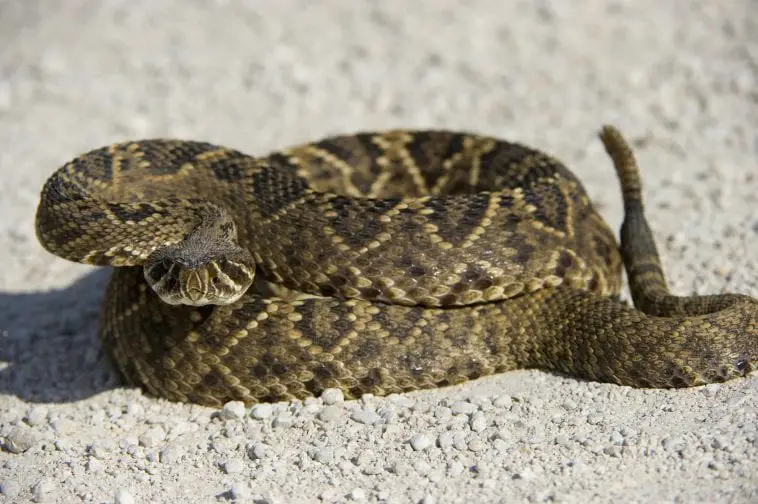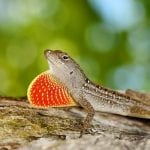Threatened rattlesnakes command respect as they are coiled defensively with their tail vibrating and head reared. They are venomous serpents that have the most dramatic warning system – their signature rattles. However, the rattling sounds in their tails are not just the only interesting in them, but their powerful fangs as well.
1. Western Diamondback
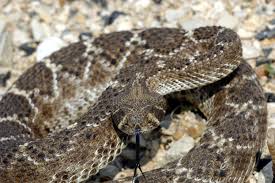
Known as the longest kind of rattlesnake in America, this western diamondback or C. atrox can grow up to 8.5 feet long. Their average sizes range from 3.5 feet to 4.5 feet. It has similar characteristics as of the eastern diamondback, such as the diamond dorsal pattern. What makes this rattlesnake different is that it has a lighter pattern than its counterpart.
When provokes, this North American snake can exhibit a bright anti-predator display. It rattles constantly with a raised coil (S-shape). Its body gets cocked and looks ready to hit prey. These rattlesnakes got various habitats since they are originally ecologically generalists.
They live in a variety of environments – flat and arid southwest American regions to its mountainous rocky spots in the country. For younger western Diamondbacks, they are exposed to being predated by roadrunners, birds of prey, and other carnivorous mammals. In some cases, human beings pose a threat as well. It happens when people start to destroy their habitats for developments.
There are over 100 000 western diamondbacks that are being killed each year for sensationalistic events and displays during rattlesnake roundups. People are convinced that these roundups play a crucial role in the population decline of its species, particularly in Oklahoma.
2. Eastern Diamondbacks
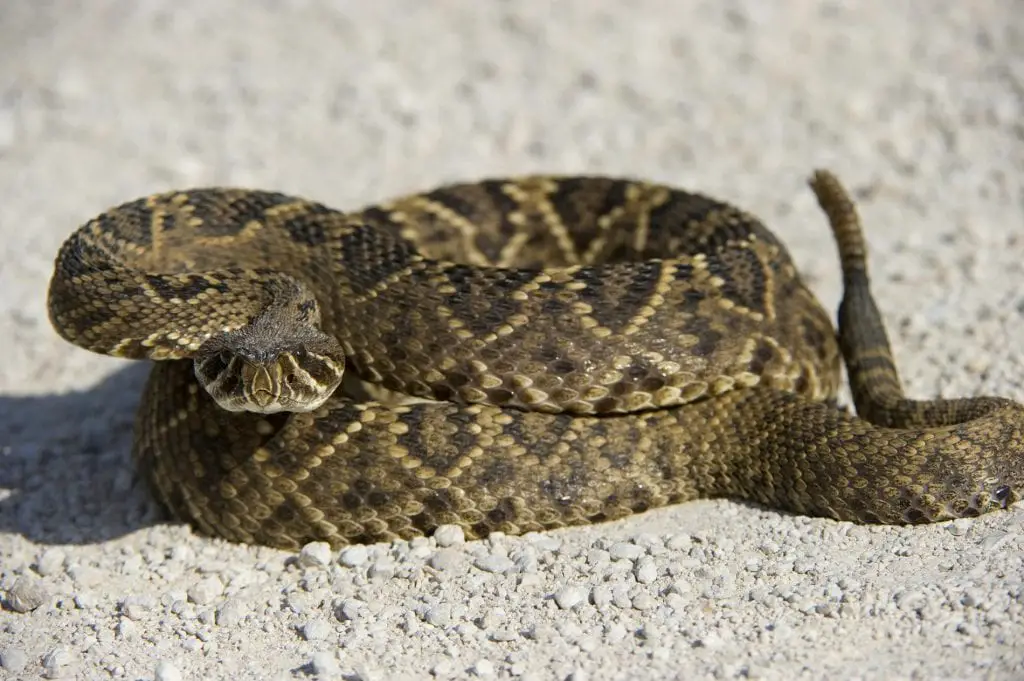
Eastern diamondback rattlesnakes have an average length of 5 feet. However, there are some of its specimen reports reaching up to 8 feet long. These snakes are recognized as the United States’ 2nd longest and most heavily bodied rattlesnake.
The Eastern diamondback or C. adamateus has a distinct dark dorsal diamond pattern. With this feature, they easily blend into their habitats well. They serve as the ambush predators that count on such camouflage.
They are comfortable living in two niches. First, they cohabitate with Gopherus polyphemus or simply known as the gopher tortoise. They use tortoise burrows during hibernation, predator evasion, and birthing. Lastly, they also survive in rotten wood stumps with the help of the root system network as a tunnel.
These rattlesnakes can be fed with quail or other small mammals. There are only a few animals that can be predators to adult eastern diamondbacks. But raptors, feral pigs, king snakes, and bobcats survive with preying younger animals.
3. Ridge-Nosed Rattlesnake

There are two known varieties of ridge-nosed rattlesnakes: the New Mexico (or C. w. obscurus) and the Arizona (C. willardi willardi) rattlesnakes. They are alike except on the dorsal distribution and patterning. They both have a raised postrum in them, which is responsible for forming an upturned ridge.
On the other hand, the Arizona ridge-nosed rattlesnake comes with reddish-brown dark scaling. This pattern runs in broken and light-colored crossbars with black scale borders. Meanwhile, the New Mexico snake has pale gray crossbars which are poorly-defined. Its face has no dominant strips while its head remains patternless.
Most population of willardi ridge nose rattlesnakes are easily found on Patagonia, Whetstone, Santa Rita and Huachuca Mountains of Arizona. The obscurus rattlesnakes are distributed in New Mexico, specifically in Animas and Peloncillo.
These snakes survive in rocky places with higher altitudes.
4. Sidewinder
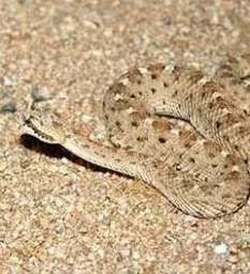
This snake, also known as C. cerastes, belongs to the smaller desert species of rattlesnakes. Sidewinders usually thrive in sandy and barren southwest American deserts. They are capable of moving forward, just like a typical snake. What makes it unique is its impressive ability to move sideways for a long period while on dunes.
Such sidewinding, like locomotion, is a way to manage hot temperatures. Doing so prevents heat absorption. Furthermore, sidewinders are characterized by J-shaped marks with diagonal courses when the said locomotion is performed. Thus, tracking on the dunes of these sidewinders are easier.
A sidewinder rattlesnake has two physical characteristics which make them easy to distinguish. First, they got a spinal ridge connected along their spine. At the same time, they also got a well-modified supraocular scale resembling the horn over its eyes.
It is often found partially buried as soon as they used “catering,” a technique in which its body flattens while being coiled in the sand. Sidewinders utilize this technique when they want to hide and attack prey. Just like other rattlesnakes, it ambushes predators. They often eat small rodents and lizards.
5. Pygmy Rattlesnakes
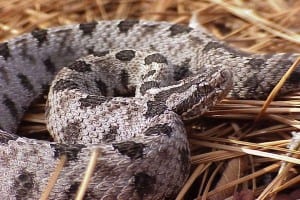
A pygmy rattlesnake has a variety of scientific names such as S. m. streckeri, Sistrurus miliarius miliarius, and S. m.barbouri. It ranges from the southeastern United States to eastern Texas. It can inhabit distinct habitats such as wet prairies, dry river bottom, palmetto, pinewoods, marshes, hardwoods, and pine flatwoods.
They also dwell in woodpiles, open grass, junk piles, logs, and rocks where there are abundant prey items. These pygmy rattlesnakes exhibit a vast range of coloration. For some of its species are widely renowned for their orange and reddish coloration. Others show up dark to black patternless features.
6. Mojave Rattlesnakes
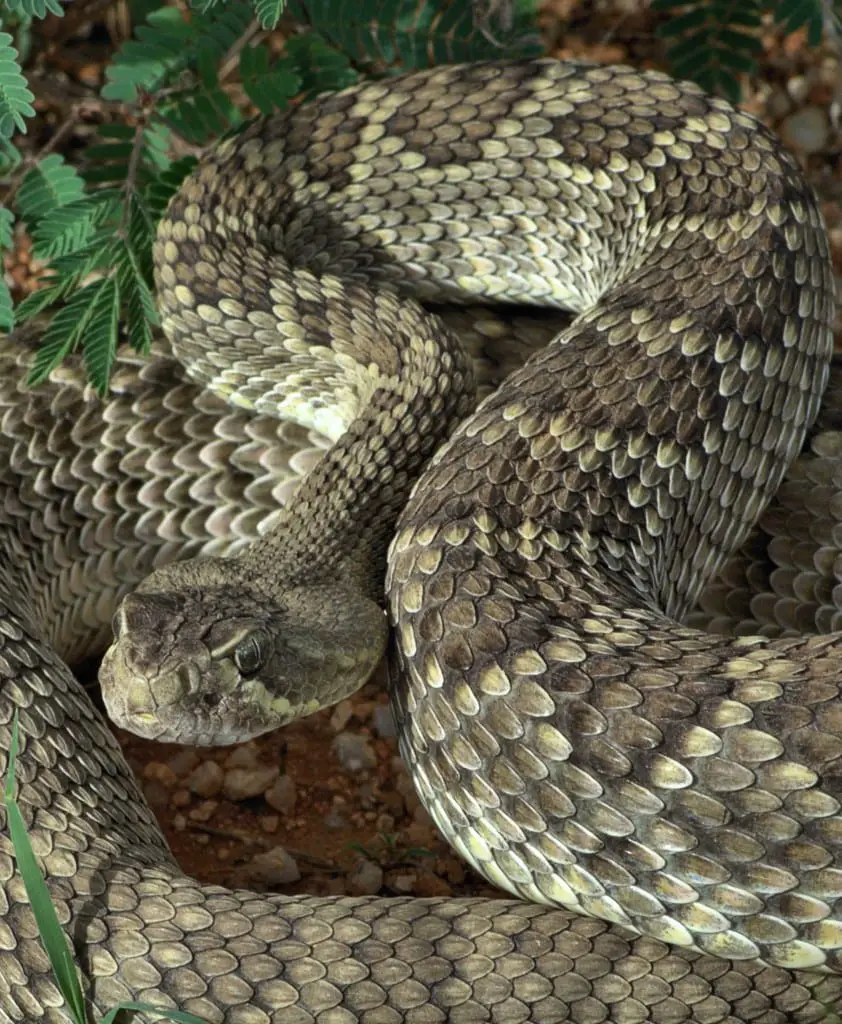
In most circumstances, this Mojave rattlesnake (or C. scutulatus) is mistaken for western diamondbacks. This is because of the similar diamond dorsal patterns that are closely similar to western and even eastern diamondback rattlesnakes. The color of its skin looks brownish to muted green.
However, two distinct characteristics make it identifiable as a Mojave rattlesnake. First, it is the facial stripes positioning. Second, it is the banding pattern of the tail. These types of rattlesnakes have 2 to 8 alternating white and black scale bands before its rattle. Plus, it has a black top segment. Take note that these white bands are usually wider than the black bands.
When it comes to the facial stripes, this rattlesnake has 2 white stripes running backward in a diagonally form from its eye to its mouth scales. One stripe comes from the front eye while the other one ends beyond its jaw angle.
For envenomation, the Mojave rattlesnake must be regarded as a serious medical concern. Different populations of this species are distributed in Texas, the southwestern part of the United States, and California. They have distinct venom compositions.
According to the venom experts, these rattlesnakes are divided into groups which are based on their properties and venom compositions. For Type A groups, they carry “Mojave toxin,” a very potent neurotoxin. For Type B groups, they possess venom known to be potent hemotoxic.
7. Timber /Canebrake Rattlesnake
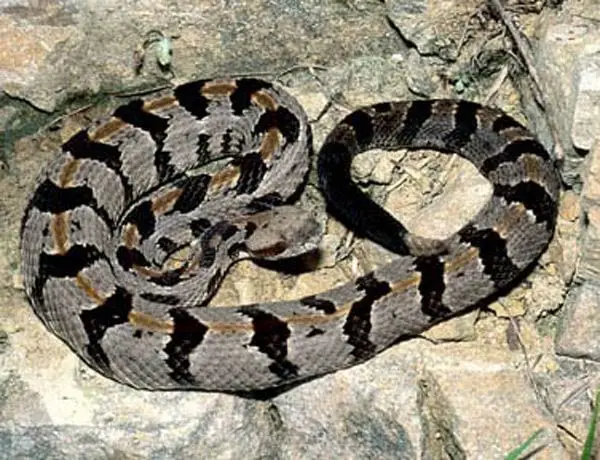
Many years ago, there are two subspecies of this rattlesnake- the canebrake or C. h. atricaudatus and the timber rattlesnake or Crotalus horridus horridus. However, scientists found out that these subspecies have a closely similar genetic structure.
But still, many people believe that the timber and the canebrake rattlesnakes remain two different species due to their morphological differences. Both types range from medium to large sizes and are heavily bodied. With dorsal patterns, they have dark chevrons and accentuated with very light edging scales. Upon reaching their tails, these chevron patterns darken.
In the eastern part of the United States, the timber rattlesnakes dwell in mountainous highlands, including rocky hillsides, deciduous forests, and meadows.
Although canebrakes are not aquatic species, they prefer wetter environments such as swamps, waterways, or bogs in hardwood forests. On the other hand, in the southern part of America, they are often found in very tall grasses such as bamboo. This is the reason why they derived such a name.
Their populations rapidly decline, and some regions are protecting their species. Some of the threats in both species are agriculture, unwarranted killing, commercial collecting, habitat destruction, and human development.
Recently, an infectious disease called the snake fungal disease has been observed in a group of timber rattlesnakes. Such infectious disease has become a major concern in the conservation status.
8. Eastern Massasauga
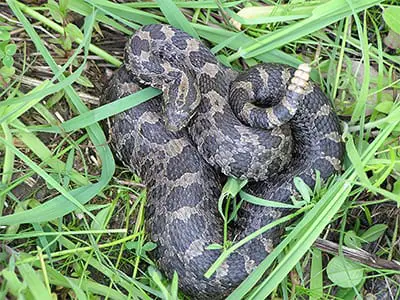
Known in the scientific name, S catenatus catenatus, eastern massasauga has been recently included in the list of threatened species by the Fish and Wildlife Service in the United States. This rattlesnake is characterized as a small yet thick-bodied species.
Eastern Massasauga rattlesnakes populate in shallow wetland portions of Iowa, Ohio, Ontario, Wisconsin, Illinois, Minnesota, Pennsylvania, Michigan, Indiana, and New York. By looking closely at its external physical structure, there are dorsal patterns of dark brown to black blotches in oval shapes. They lie on the gray and reddish-brown background.
Some contributing factors for its population decline are farming, changes in the weather pattern, and habit destruction. This population has been affected by the snake fungal disease as well, according to some reports.
9. Banded Rock Rattlesnake

Also called C. Lepidus klauberi, this banded rock rattlesnake belongs to the small categories of rattlesnakes living in America. It rarely achieves 2 feet in length. It is found in the mountains of Arizona, New Mexico, and Texas.
These banded rock rattlesnakes are characterized to have a cryptic nature. They are not often observed based on size, speed, and coloration. They inhabit in elevated spots that are as high as 8, 000 feet such as rocky outcrops, rocky areas in conifer and pine-oak forests, and open rockslides.
10. Twin-Spotted Rattlesnake
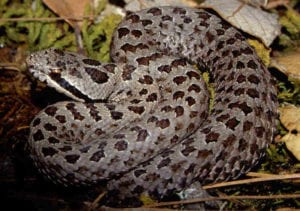
The twin-spotted rattlesnakes (or C. pricei pricei) are the smallest types of rattlesnakes dwelling in America. This species can be found in Santa Rita, Pinaleno, Huachuca, and Chiricahua of the southeast Arizona mountains. It is easily found among hardwood, conifer forests, and rock slides. They stay at elevations with at least 6, 000 feet.
There are also limited reports of human envenomations, but no fatalities recorded.
11. Southwestern Speckled Rattlesnake

These Southwestern Speckled Rattlesnakes (Crotalus Pyrrhus) belong to the species of the venomous pitviper. They are usually living in the northwestern part of Mexico and the southwestern part of the US. They are medium in size and mostly active at night to feed on smaller mammals. With coloration, it varies on the soil and rocks of their habits.
The adult speckled rattlesnakes grow an average size of 91 cm or 3 feet. Sometimes, it exceeds up to 120 centimeters or 4 feet. Their ground colors range from nearly white, pink, yellow, and brown and gray with black and white speckles. They have ringed tails, and patterns may be blotches, bands, or rhombs.
Other names for Crotalus Pyrrhus are pale rattler, red rattlesnake, white rattlesnake, Mitchell’s rattlesnake, pallid rattlesnake, speckled rattlesnakes, and bleached rattlesnake.
The case of envenomation reported by Hartnett (1931) has described the effect after a man was bitten by this species on his thumb. The severe pain for an hour was experienced after. Then, it was followed by swelling and discoloration. His palm had a large blister while his wrist and fingers were full of blebs.
12. Tiger Rattlesnake
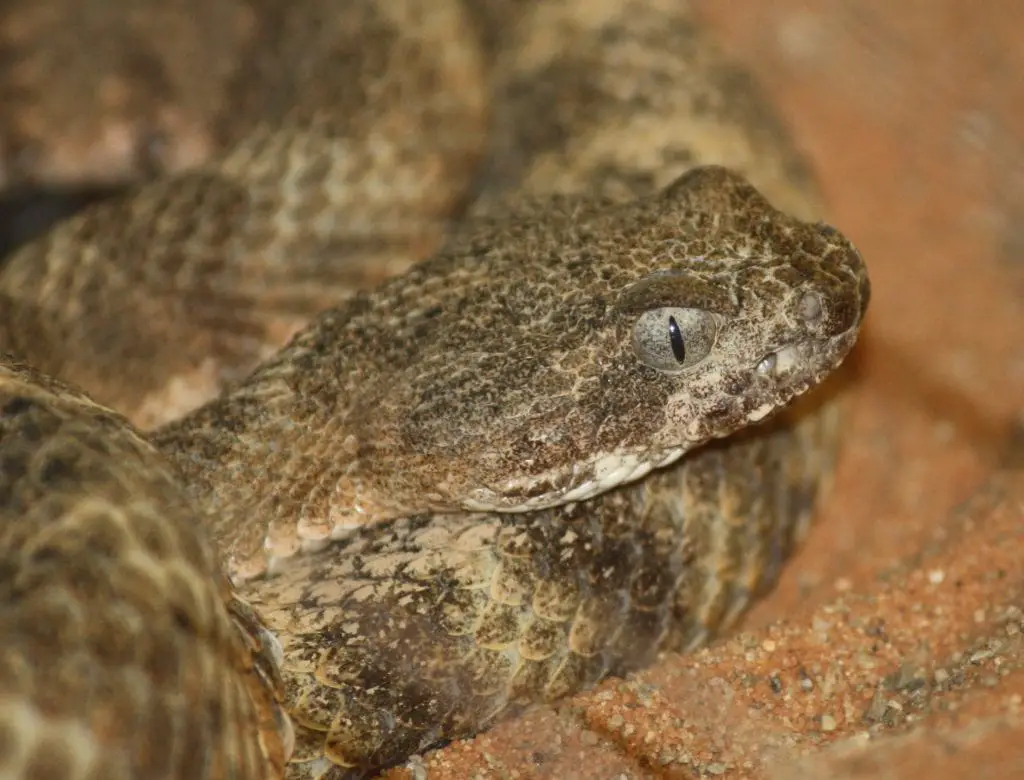
The tiger rattlesnake, or crotalus tigris, is a medium-sized pitviper with 88.5 centimeters as the largest specimen recorded. This species dwells in mesquite grasslands and rocky habits at elevations up to 1, 400 meters near sea level. They are commonly found in southeastern Arizona.
They have irregular brownish or greyish dorsal crossbands. They have a small head in a triangular shape, just like the size of a big rattle producing loud rattles.
General Information About Rattlesnakes
Generally, rattlesnakes are widely recognized as a highly specialized and venomous type of reptile. They feature triangle-shaped heads and large bodies. They belong to North American’s most iconic snakes because of their “rattle” characteristics, which are found at the end of their tails.
Because of muscle contractions, the rattling sound is produced by clicking together of the scales. There are numerous species of rattlesnakes living in different parts of the US.
1) Diet
Rattlesnakes consume rodents, but also survive in insets and some smaller reptiles as their prey. Since they are classified as pit vipers, they possess some heat-sensing organs that can be found near their eyes. The role of these pits is to see their prey’s signature.
They can accurately strike their victims even in complete darkness. They use the hunting technique called ‘ambush predation’ in which they wait for smaller mammals to venture and strike them with their venomous fangs.
2) Behavior
Whenever they feel a threat around them, rattlesnakes have their ways to stay protected. They protect themselves by camouflage coloration. They blend in with the habitats. Others simply silently escape.
They choose to defend their habitats by showing their defensive pose. Then, they shake their rattles for warding off predators. Once startled, they attack right away. However, they only strike with their bodies coiled.
3) Conservation
These species are generally stable. However, a few species and subspecies are considered threatened. They are also vulnerable to killing as they are perceived as dangerous animals than vital predators.
There are more sources online that provide helpful information about rattlesnakes and other hidden facts about them. One interesting thing to know is how they evolved over the years while populating the wild of North America.
Although these snakes often scare people, they have a paramount role in the ecosystem by controlling the population growth of smaller mammals. More species of rattlesnakes can be found in different spots of North America, which may have unique characteristics and behavior.

